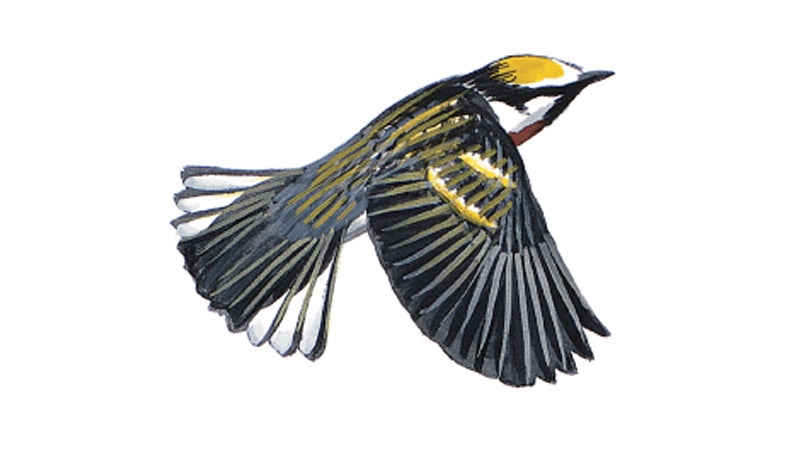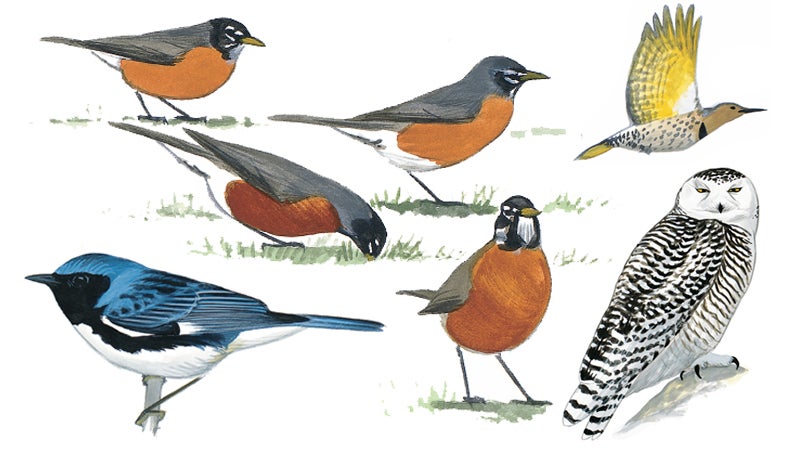David Allen Sibley has spent nearly his entire life watching birds. His pressed khaki pants, leather walking shoes, quiet voice, calm demeanor, and deliberate, slow way of articulating his thoughts reveal him as someone willing to sit in the woods for hours with a pair of binoculars around his neck.
High
“One of the things that IтАЩve come away from this discussion with is a great respect for the authors, editors, and publishers who put together these extremely useful guidebooks. And to be able to do it at a price that everyone can afford is very impressive.” тАФChuck Hundertmark, Denver Field Ornithologists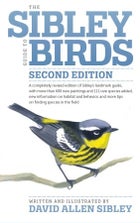
│з╛▒▓·▒Є▒Ё▓ттАЩs father was an ornithologist, and the birding-gene was passed along to Sibley and his brother, who both became interested in birds early on. Sibley started his (a birderтАЩs log of species identified) when he was seven, and by the age of eight, he was learning to band birds. He quit college in 1980 after a single year to fully commit his time to birding. In 1993 he started painting birds from his home and studio in Concord, Massachusetts, and in 2000 he released The Sibley Guide to Birds.
│з╛▒▓·▒Є▒Ё▓ттАЩs, as itтАЩs called, is an illustrated guidebook of nearly 7,000 images describing 906 species. As a comprehensive description of North American birds done by a single author and artist, the work stands alone among contemporary guidebooks. Experts regard The Sibley Guide to Birds on the same level as the works of John James Audubon and Roger Tory Peterson.
Each species beings with a pencil outline. Every bird is a drawing before itтАЩs a painting. Through perfecting the proportions and the posture and the size of a bird, Sibley attempts to capture and convey the тАЬspirit of the bird.тАЭ As he draws it, he develops an understanding of the species. He calls it an in-depth interview. With the sketch complete, Sibley transfers the drawing to a 14- by 22-inch sheet of paper to begin painting.
тАЬBut it all depends on the pencil outline,тАЭ Sibley says. тАЬIf the outline of the bird is not right, no amount of painting technique can rescue it.тАЭ
Before the days of the Internet, illustrators used books, photographs, and magazine clippingsтАФin addition to personal experienceтАФto describe a species. Sibley has personal experience with 97 percent of the birds (all but 26 speciesтАФтАЬa few rare pelagic birdsтАЭ) described in the second edition. With that first-hand knowledge and a wealth of Internet references and photographs at hand, he begins to paint the bird.
Sibley adds layers of opaque watercolors, also known as gouache, over the sketch. Details of the birds emerge in schematic, impressionistic strokes. He confesses little patience for painting; he likes to see fast results.
The of │з╛▒▓·▒Є▒Ё▓ттАЩs guidebook includes 111 new species. The images of the birds are larger in the latest edition, though some of the text is finer and smaller. The maps showing seasonal ranges of the birds have been changed for increased clarity and accuracy. Sibley also wrote a new paragraph for each species about its status and distribution. All of the changes to the second edition intend to reinforce │з╛▒▓·▒Є▒Ё▓ттАЩs fundamental goal: To help people successfully identify birds in the field.
The Sibley Guide to Birds is found in more birdersтАЩ fanny packs than any other guidebook in North America. Some birders attribute its widespread use to the variety of positions and postures shown. Others say itтАЩs because the book shows more plumage variations than any other. Whatever the reason, │з╛▒▓·▒Є▒Ё▓ттАЩs guidebook has become the go-to standard for professionals and amateurs alike.
тАЬNo one ever says, тАШcheck your Nat Geo,тАЩтАЭ says Chuck Hundertmark, president of Denver Field Ornithologists. тАЬItтАЩs always, тАШcheck your │з╛▒▓·▒Є▒Ё▓ттАЩs,тАЩ or тАШdo you have your │з╛▒▓·▒Є▒Ё▓ттАЩs?тАЩт╢─Э
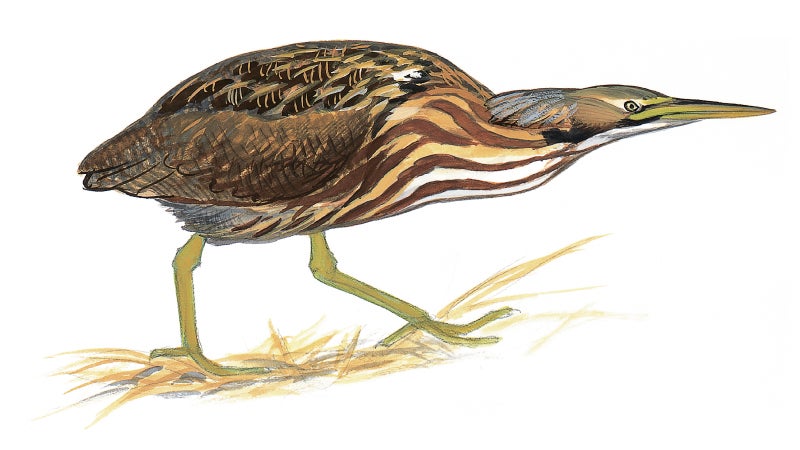
│з╛▒▓·▒Є▒Ё▓ттАЩs first edition sold 400,000 copies in its first 15 months and a total of 1.3 million copies to date. Anticipation for the second edition suggests similar sales, and early reviews of the book have been overwhelmingly favorable. The most consistent criticism is that the printingтАФnot │з╛▒▓·▒Є▒Ё▓ттАЩs artworkтАФis too dark. Some reviewers argue that the contrast between the darker hues of birdsтАЩ feathers is lost due to faulty coloration by the printer.
тАЬThe printing issue puts me in a challenging spot,тАЭ Hundertmark says. тАЬMost birders who look at │з╛▒▓·▒Є▒Ё▓ттАЩs as a field guide are primarily looking at the illustrations, and I think the print quality [in the second edition] makes it hard to call this printing workable in the field.тАЭ
The first edition, printed in Hong Kong, was also criticized for faulty coloration upon release, which is common among illustrated guidebooks. Three printings later, the consensus among birders was that the problem had been fixed. The second edition was printed in China and will likely undergo similar color-fixes in subsequent printings.
Sibley feels that the printing criticism is largely a function of people comparing the colors of the first edition to those of the second. He grants that some of the second editionтАЩs illustrations are slightly too dark (such as the image of the vermillion flycatcher on page 349), and some illustrations will need to be adjusted. But, he says, the off-set coloration is not severe enough to prevent identification. In general he feels that the colors in the second edition are more accurate and more closely resemble his original paintings. Furthermore, he says, color is a subjective personal analysis, and one that is always a function of contextтАФthe way we perceive colors is affected by nearby colorsтАФan effect known as simultaneous contrast.
Sibley has allies in his defense of the newest edition. Ted Floyd, editor of , thinks that illustrations in the second edition are more faithful to how birds appear in the field.
тАЬIтАЩm not convinced thereтАЩs an error here,тАЭ he says of the second edition. тАЬItтАЩs a pretty narrow criticism of a massive achievementтАФlike kicking the Constitution to the ground because the wording of the Second Amendment is unclear. Color reproduction is important, but I think people are focusing on it too much with this edition.тАЭ
│з╛▒▓·▒Є▒Ё▓ттАЩs fundamental criteria for how he presents a species is that he wants to show you what youтАЩll see when you see the bird. In the first edition, he felt that he inconsistently showed some wing under parts in shadow and some as though lit. In the second edition, he wanted every species to have dark underwings in flight for two reasons. One, consistency between images makes comparing them easier, which is essential to identifying birds. Two, when you encounter a bird in the field youтАЩre more likely to see its underwing in shadow than lit, mostly because the light source (usually the sun) shines from above the bird.
тАЬWhat IтАЩm trying to do in the paintings is simplify the bird down to what you see in the field through binoculars at a distance,тАЭ he says. тАЬAdding too much detail would be a distraction, the same way that adding habitat would be a distractionтАж My overall theory of field guide illustration is that the images should be simple enough that they just suggest the bird.тАЭ
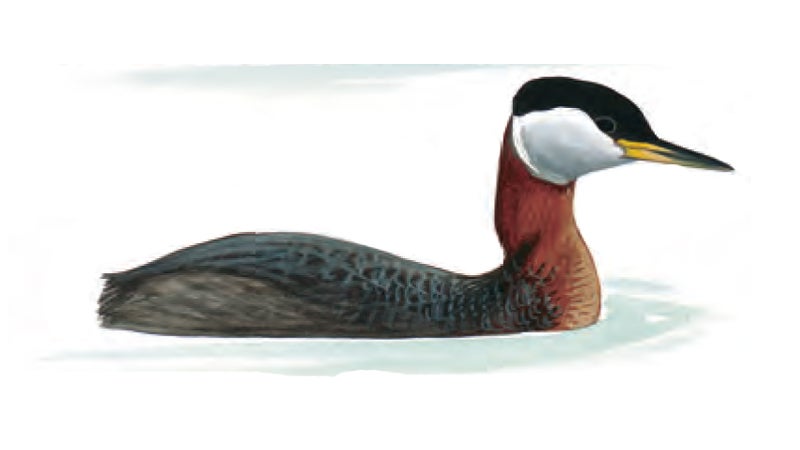
In the same way that a pencil sketch leaves detail to the viewer, Sibley believes his images require the reader to fill in the finer points of the birds. By leaving detail from his images, the reader interacts with the image in a way that wouldnтАЩt occur through a photograph or more detailed painting. His theory behind omitting habitat from the imagesтАФall but the suggestion of a fence post or tree limb or sand beachтАФleave setting to the imagination. According to Sibley, that allows you to superimpose your own experience over the image, which not only makes recognizing a species easier, but also enhances your personal experience with the birds and the guidebook.
The volume and scope of the field guide make it a work of art. Color gradients flow down the page, from fledglings to breeding adults, from monotone fuzz to Technicolor plumage. From one species to the next, subtle changes within families give way to abrupt changes in size and type of bird. Rails, coots and cranes follow hawks and vultures; parrots follow falcons; hummingbirds follow swifts, which follow nightjars, which follow owls. And appearing before all other birds is a page of extinct species, which is new to the second edition.
Included on the extinct species page is the ivory-billed woodpecker, which is │з╛▒▓·▒Є▒Ё▓ттАЩs opinion. Conventional science agrees with Sibley, though some people are sure the bird still lives in the dark timber of Arkansas. But in the same way that the font is smaller and finer and the illustrations are larger in the second edition, the guidebook as a whole is │з╛▒▓·▒Є▒Ё▓ттАЩs personal interpretationтАФstaked on 25 years of art-making and a lifetime of observationтАФof how to describe North American birds.
For those who love it, birding provides an intimacy with wildlife and the environment. To the devout carriers of The Sibley Guide to Birds, the book represents the finest blend of art and science, something that conveys the appeal of birds and at this same time is inherently useful. With its unparalleled descriptions of subspecies and plumage variations, professionals rely on the guide unlike any other in print. For the casual birder who merely wants to know whatтАЩs eating the seed, │з╛▒▓·▒Є▒Ё▓ттАЩs is the most digestible bird book on the rack.
тАЬItтАЩs just a directoryтАФthe birds and their namesтАФbut thereтАЩs so much more you can learn from it,тАЭ he says. тАЬItтАЩs an entry point to a deeper understanding or appreciation or familiarity with the birds. And that can take you in any direction a person wants.тАЭ
